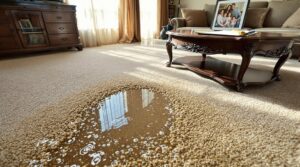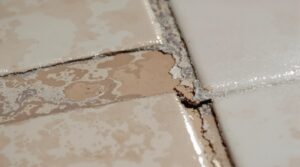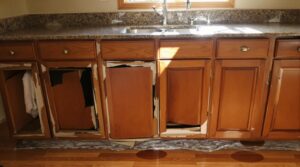Maximizing water damage insurance claims requires prompt action and detailed documentation immediately after discovery. Property owners should photograph all damage, stop the water source, and notify their insurance company without delay. Working with a public insurance adjuster often leads to settlements up to 747% higher through professional advocacy and negotiation expertise. Extensive documentation, understanding policy coverage, and professional representation form the foundation for securing the highest possible settlement. The following strategic approaches reveal essential steps for ideal claim outcomes.
Key Takeaways
- Document all damage extensively with photos, videos, and written records immediately after discovering water damage to build strong evidence.
- Hire a public insurance adjuster who can increase settlement amounts by up to 747% through expert negotiation and damage assessment.
- Create detailed inventories of damaged items, including descriptions, values, and keep all receipts for repairs and temporary accommodations.
- Act quickly to prevent secondary damage through proper drying and moisture control while maintaining documentation of all mitigation efforts.
- Review policy coverage limits and exclusions thoroughly, then maintain a firm negotiating stance supported by comprehensive evidence.
Understanding Your Water Damage Insurance Policy
When property owners face water damage, understanding their insurance policy becomes the critical first step in maximizing their claim. A thorough policy comparison reveals that while sudden and accidental damage from burst pipes, appliance overflows, and roof leaks typically receives coverage, gradual deterioration and maintenance-related issues do not.
Standard policies maintain specific coverage exclusions that property owners must recognize. These commonly include flood damage, which requires separate insurance, and damage resulting from neglect or inadequate maintenance. Additionally, gradual issues like slow leaks or foundation seepage fall outside standard coverage parameters.
However, homeowners can enhance their protection through optional coverages for specific perils such as mold or sewer backup.
To effectively navigate coverage terms, property owners should carefully review their policy documentation, focusing on covered perils, exclusion clauses, and coverage limits. Understanding these elements enables informed decisions about additional coverage needs and strengthens their position during the claims process.
Immediate Steps After Water Damage Discovery
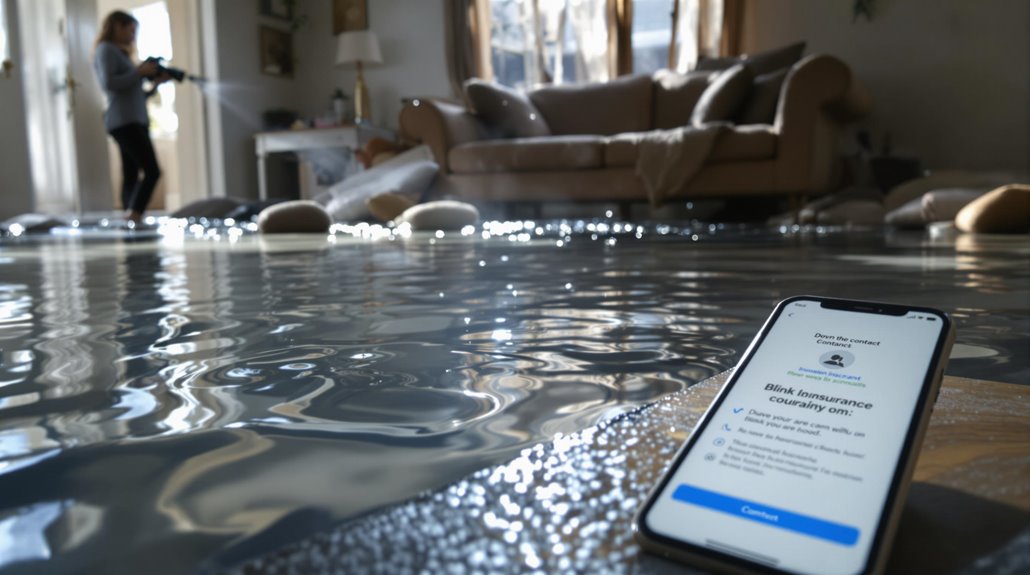
The most critical actions in the moments following water damage discovery can greatly impact insurance claim outcomes and property preservation.
Immediately documenting all damage through detailed photos and videos while simultaneously stopping the water source creates a strong foundation for maximizing claim value.
Promptly notifying the insurance company initiates the claims process and demonstrates proactive damage mitigation, which insurers view favorably when evaluating compensation.
Document Everything Immediately
Because proper documentation serves as the foundation for successful water damage claims, property owners must begin capturing evidence immediately upon discovering water-related issues.
Extensive documentation includes taking clear photos and videos of all affected areas, capturing standing water, structural damage, and compromised belongings from multiple angles.
The timing of documentation is critical for maximizing claims. Property owners should create a detailed inventory of damaged items, maintain receipts for emergency repairs, and record dates and times of all actions taken.
Professional restoration experts can provide valuable guidance in the documentation process, ensuring all damage is properly captured, including hidden issues that may not be immediately apparent.
This thorough approach supports insurance claims, reduces potential disputes, and helps secure appropriate compensation for water-related damages.
Stop Water Source First
Securing personal safety and stopping the water source immediately represent critical first steps when dealing with water damage incidents. Implementing proper water shutoff procedures begins with locating the main water valve and turning it off promptly. Property owners should familiarize themselves with emergency repair options, including temporary solutions like using duct tape or towels to minimize ongoing leaks until professional assistance arrives.
| Action | Primary Step | Backup Plan |
|---|---|---|
| Locate Source | Find main valve | Identify local shutoffs |
| Stop Flow | Turn off water supply | Apply temporary patches |
| Seek Help | Contact plumber | Call insurance company |
When the water source cannot be immediately identified or accessed, contacting emergency services or professional plumbers becomes essential to prevent further damage and maximize potential insurance claims.
Call Insurance Right Away
Once water flow has been stopped, immediate contact with the insurance company becomes a top priority for maximizing claim potential.
Insurance notification procedures should be initiated promptly to expedite the claims process and guarantee proper documentation from the start. Property owners must provide initial details about the water damage source and conduct an immediate damage assessment.
During the initial insurance contact, policyholders should request specific guidance on documentation requirements and next steps. This includes taking thorough photos and videos of affected areas, creating detailed inventories of damaged items, and preserving all relevant receipts.
The insurance company may also provide critical instructions for preventing secondary damage, such as mold growth, which could impact the claim's value. Prompt notification also demonstrates the policyholder's commitment to mitigating further damage, a factor that can positively influence claim outcomes.
Essential Documentation Practices

Proper documentation serves as the cornerstone of successful water damage insurance claims. Thorough documenting damage requires extensive photographic and video evidence, accompanied by detailed written records of all observations. Property owners should capture both wide-angle shots and close-ups of affected areas while maintaining a chronological record of how conditions evolve over time. Additionally, it’s essential to categorize the various types of water damage claims that may arise from different incidents, such as burst pipes, flooding, or appliance malfunctions. By clearly identifying the cause and extent of the damage, property owners can streamline the claims process and improve their chances of receiving a fair settlement from their insurance provider. Moreover, keeping all correspondence with the insurance company organized will further enhance the effectiveness of the claim, ensuring that no critical details are overlooked.
Effective inventory management involves creating detailed lists of damaged items, including descriptions, purchase dates, and estimated values. This documentation should encompass both salvageable and non-salvageable items, with precise notes about their pre-damage condition and replacement costs.
Property owners must retain all receipts, invoices, and records of communications with insurance providers and service professionals. Documentation should also include assessments from qualified professionals and records of any temporary repairs undertaken to prevent further damage.
Maintaining organized records of all expenses, including temporary accommodations and emergency services, strengthens the claim's validity and increases the likelihood of fair compensation.
Working With Public Insurance Adjusters

When managing complex water damage claims, partnering with a qualified public insurance adjuster can substantially increase settlement outcomes and streamline the claims process.
The public adjuster benefits extend beyond mere convenience, as these professionals leverage their expertise and insider knowledge to advocate exclusively for policyholders' interests.
Studies indicate that claims handled by public adjusters often result in settlements up to 747% higher than those managed independently.
These specialists excel in claims negotiation strategies, utilizing their thorough understanding of insurance policies to identify all compensable damages. Their teams meticulously document losses, compile persuasive evidence, and negotiate directly with insurance companies to maximize payouts.
When selecting a public adjuster, homeowners should prioritize those with extensive water damage experience and insurance industry background.
The most reputable firms operate on contingency fees, offering free initial consultations and detailed explanations of their services, ensuring aligned interests throughout the claims process.
Negotiating Tactics for Maximum Settlement
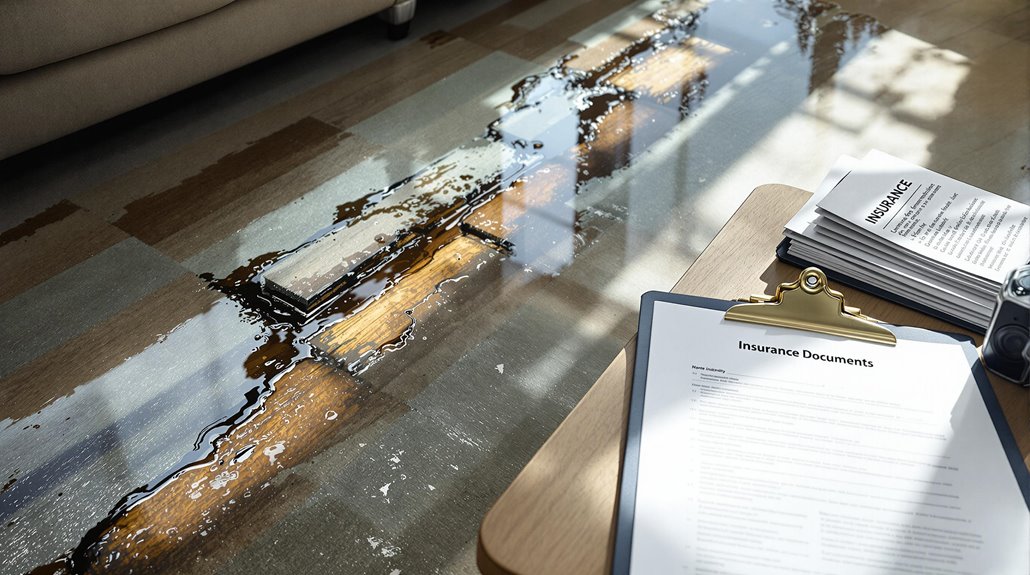
Successful negotiation of water damage claims requires meticulous photographic documentation of all affected areas, materials, and belongings before repairs begin.
Insurance policyholders should thoroughly review their coverage limits and understand specific provisions for water damage before entering negotiations.
While maintaining a firm stance on fair compensation, claimants must communicate professionally with adjusters, backing their position with clear evidence and detailed documentation of all damages.
Document Everything With Photos
Thorough photographic documentation serves as a foundational strategy for maximizing water damage insurance claims. Effective photographic techniques and visual storytelling create compelling evidence that strengthens claim negotiations. Insurance adjusters rely heavily on visual documentation to assess damage and validate claims.
- Capture wide-angle shots to establish the full scope of damage
- Document the progression with time-stamped photos
- Take detailed close-ups of specific damage points
- Create extensive before-and-after comparisons
- Record video walkthroughs for complete coverage
A systematic approach to photographing water damage helps guarantee every affected area is properly documented.
Maintaining an organized photographic inventory with detailed descriptions and estimated values provides essential support during the claims process. This visual evidence becomes particularly valuable when disputing coverage limitations or negotiating settlement amounts with insurance providers.
Know Your Policy Limits
Understanding insurance policy limits forms the cornerstone of effective water damage claim negotiations. Many policies cap water damage coverage at $10,000, which often proves insufficient when accounting for both mitigation and repair costs. This limit typically includes essential services like structural drying, leaving minimal funds for necessary restoration work.
Policyholders must carefully review their coverage limits and policy exclusions before initiating claims. Some policies contain specific water damage restrictions or require the use of preferred contractors for maximum coverage.
Additionally, policies may mandate prompt notification of mitigation services, sometimes within days of the incident. To optimize claim outcomes, property owners should consider engaging legal assistance or insurance specialists who can navigate complex policy provisions and guarantee fair compensation within the established limitations.
Stay Firm Yet Professional
Professional negotiation tactics serve as a powerful tool for maximizing water damage claim settlements. By implementing effective negotiation strategies while maintaining professionalism, claimants can strengthen their position and achieve better outcomes.
The key lies in balancing assertiveness with respectful communication throughout the claims process.
- Present detailed documentation and evidence to support counterclaims
- Remain calm and composed when challenging lowball offers
- Communicate clearly and factually about damage assessments
- Request written explanations for insurance company decisions
- Focus discussions on scope of repairs rather than costs
A firm yet professional approach demonstrates credibility and expertise while fostering productive dialogue with adjusters.
This method allows claimants to effectively challenge inadequate offers while maintaining constructive relationships throughout negotiations, ultimately leading to more favorable settlements that accurately reflect the extent of water damage repairs.
Preventing Secondary Damage and Loss

Swift action to prevent secondary damage is essential after the initial water incident occurs. Effective water removal and drying techniques must be implemented immediately to minimize potential losses.
Property owners should prioritize moving undamaged items to dry, secure locations while utilizing dehumidifiers and proper ventilation to control moisture levels.
Professional moisture monitoring and antimicrobial treatments play vital roles in preventing mold growth and structural deterioration. Employing moisture meters helps track progress and guarantee thorough drying of affected areas.
Special attention must be given to detecting hidden moisture pockets that could compromise structural integrity or foster mold growth.
The implementation of preventive measures, including proper drainage systems and regular maintenance of gutters and downspouts, helps safeguard against future incidents.
Installing water detection devices and maintaining proper seals around windows and doors further protects the property from water intrusion, ultimately strengthening the claim's documentation and validity.
Common Insurance Company Tactics to Avoid

Insurance companies employ various tactics to minimize or deny water damage claims, making it essential for policyholders to remain vigilant throughout the claims process. Understanding common insurer tactics can help homeowners better protect their interests and secure fair compensation for water damage.
Insurance companies frequently implement strategies to reduce claim payouts through detailed scrutiny and documentation requirements. Key practices to watch for include:
- Citing pre-existing conditions based on home inspection reports
- Requesting extensive maintenance records and plumber documentation
- Using policy exclusions to limit or deny coverage
- Offering low initial settlements to test claimant resolve
- Emphasizing policyholder negligence or maintenance failures
Homeowners should prepare for these tactics by maintaining thorough claim documentation, understanding their policy coverage, and carefully reviewing all communication from insurers.
Being proactive in addressing potential objections and maintaining detailed records of damage, repairs, and maintenance history can help counteract common insurance company strategies designed to minimize claim settlements.
Legal Rights and Professional Support Options

Understanding legal rights and securing professional support are vital elements in maximizing water damage claims. Property owners can establish neighbor liability when alterations to adjacent properties cause excessive water flow beyond natural conditions. Most states apply the reasonable use principle, requiring evidence that a neighbor's modifications unreasonably changed natural water patterns.
Legal professionals and public adjusters play significant roles in traversing complex claims processes. Attorneys specializing in water damage can help document evidence, negotiate with insurance companies, and pursue necessary legal actions. They guarantee proper compensation for repairs, temporary housing, and other related expenses.
Professional support becomes particularly valuable when dealing with disputed claims or insurance company resistance.
Successful claims require thorough documentation, including photographs, repair estimates, and detailed records of all communications. These materials strengthen negotiating positions and support legal arguments when seeking compensation for water damage repairs and associated costs.
The Benefits Of Consulting A Public Adjuster

Public adjusters offer specialized expertise in maneuvering complex water damage insurance claims, combining their knowledge of policy terms with professional assessment tools to uncover hidden damages and maximize potential settlements.
Their objective representation includes thorough documentation of damages, precise cost estimations, and strategic negotiations with insurance companies to secure fair compensation.
Expertise In Insurance Claims
When faced with the complexities of water damage claims, consulting a public adjuster can greatly improve a policyholder's chances of receiving fair compensation. Public adjusters possess extensive knowledge of the claims process and can identify hidden damages that property owners might overlook. Their expertise guarantees thorough documentation and proper presentation of claims to insurance companies.
Key aspects of a public adjuster's expertise include:
- Detailed understanding of insurance policy terms and conditions
- Advanced knowledge of damage assessment techniques
- Professional documentation of all property damages
- Strategic claim preparation and submission
- Expert interpretation of coverage limitations and exclusions
This specialized knowledge enables public adjusters to navigate complex insurance requirements while maximizing claim settlements for water damage repairs and restoration.
Objective Damage Assessment
A thorough, objective damage assessment stands as one of the most valuable benefits of working with a public adjuster during water damage claims. Their advanced damage assessment techniques guarantee extensive documentation of both visible and hidden damage, utilizing specialized tools like moisture meters and thermal imaging equipment.
Professional adjusters employ proven claim documentation strategies to create detailed reports that capture structural weaknesses, environmental hazards, and potential secondary issues like mold growth.
This methodical approach includes thorough photographic evidence and precise measurements of affected areas, creating an indisputable record of damage. The resulting documentation strengthens the policyholder's position during negotiations with insurance companies, as every aspect of the damage is professionally verified and recorded.
This level of detail often proves vital in securing fair compensation for water damage claims.
Streamlined Claim Process
Engaging the services of a public adjuster greatly streamlines the complex water damage claims process, transforming an overwhelming experience into a manageable sequence of events.
These professionals handle all aspects of documentation, communication, and negotiation with insurance companies, allowing property owners to focus on recovery.
- Expert management of claim documentation and paperwork submission
- Professional evaluation using advanced tools like moisture meters
- Direct communication handling with insurance companies
- Strategic negotiation to counter lowball settlement offers
- Extensive assessment of all available coverage options
Public adjusters provide invaluable guidance throughout the claim process, ensuring that property owners receive fair compensation for their losses.
Their expertise in policy interpretation, damage assessment, and claims preparation considerably increases the likelihood of a successful settlement while reducing stress and complexity for the policyholder.
Higher Claim Payouts & Settlements
Professional representation by public adjusters consistently leads to higher claim settlements for water damage incidents, with payouts often markedly exceeding what property owners might secure on their own.
Through thorough damage assessments and expert negotiation skills, adjusters identify various claim types and evaluate essential payout factors that property owners might overlook.
Public adjusters utilize specialized tools like moisture meters and thermal imaging to uncover hidden damages, ensuring all aspects of the loss are documented.
Their deep understanding of insurance policies, combined with knowledge of state regulations, enables them to advocate effectively for maximum compensation.
About The Public Claims Adjusters Network (PCAN)
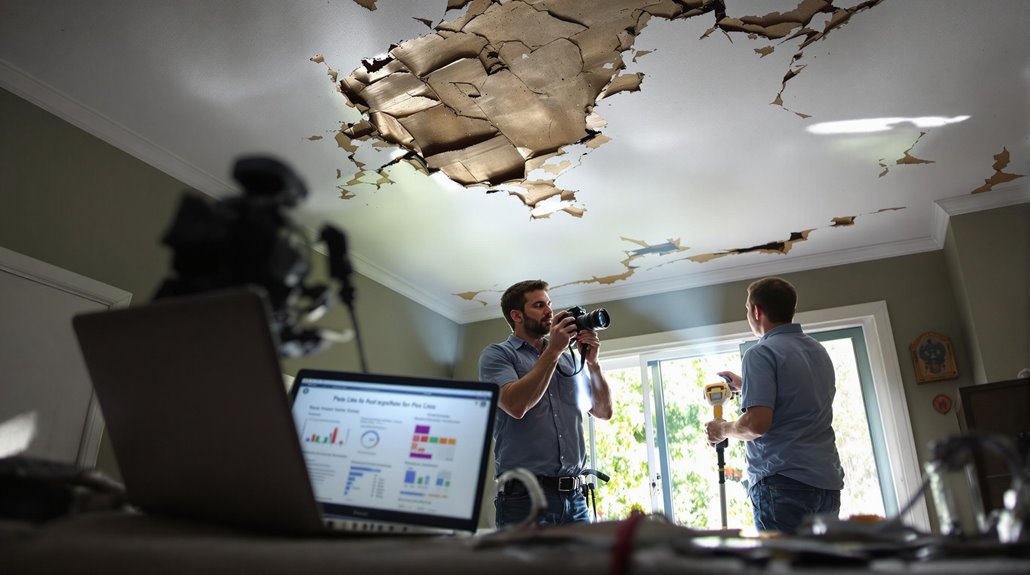
The Public Claims Adjusters Network (PCAN) stands as one of the nation's most all-inclusive insurance advocacy organizations, representing policyholders across all 50 states and international territories. This extensive network of licensed professionals specializes in maximizing insurance claim benefits while ensuring fair settlements for property owners facing losses.
PCAN's core services include:
- Thorough policy review and interpretation
- Expert damage assessment and documentation
- Professional claims presentation and negotiation
- Construction cost analysis and valuation
- Business interruption calculations
Operating on a contingency fee basis, PCAN's adjusters leverage their extensive knowledge of insurance policies, construction costs, and property valuation to advocate effectively for policyholders.
Their expertise extends beyond basic claim filing to include complex loss scenarios, requiring detailed understanding of both immediate and long-term property damage implications.
This professional network serves as a crucial intermediary between policyholders and insurance companies, streamlining the claims process while protecting clients' interests throughout negotiations.
Frequently Asked Questions
Will Filing a Water Damage Claim Increase My Future Insurance Premiums?
Filing a water damage claim typically results in insurance premium increases ranging from 7-10%, though actual increases vary based on claim severity, location, and individual insurance company policies.
How Long Can I Wait Before Filing a Water Damage Claim?
Insurance policies typically require water damage claims to be filed within 48 hours of discovery. Delaying beyond policy-specified claim timelines risks denial and can lead to additional uncovered damage.
Can I Stay in My Home During Water Damage Repairs?
Like a ship in rough waters, homeowners can typically remain during repairs, though safety concerns and severity may require temporary living arrangements. Professional assessment determines if staying is feasible.
Are Appliance Malfunctions Causing Water Damage Covered by Manufacturer Warranties?
Appliance warranties typically exclude water damage caused by external factors or user negligence. Coverage only applies to manufacturing defects, while damage from appliance malfunctions may be covered by homeowners insurance instead.
What Happens if Water Damage Spreads to My Neighbor's Property?
Studies show 37% of neighbor disputes involve water damage. When water damage spreads to adjacent properties, homeowners may face neighbor liability claims and should immediately notify their property insurance provider for coverage protection.
